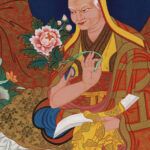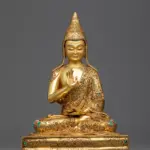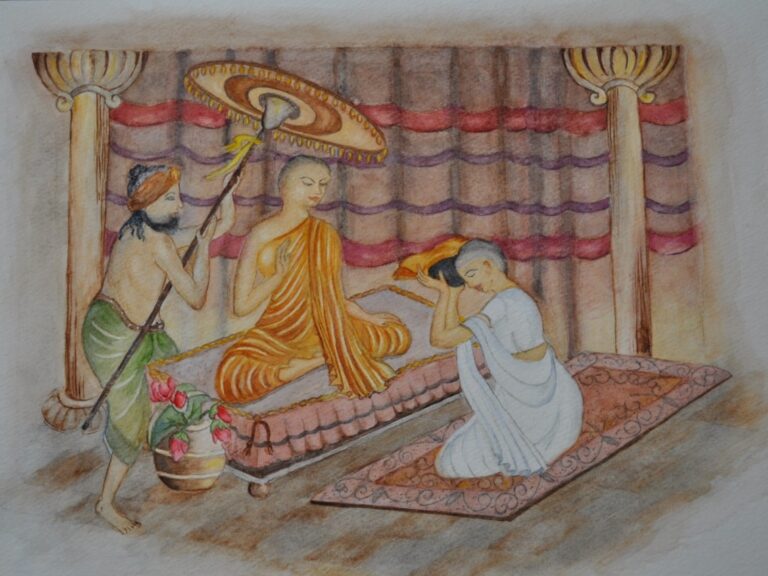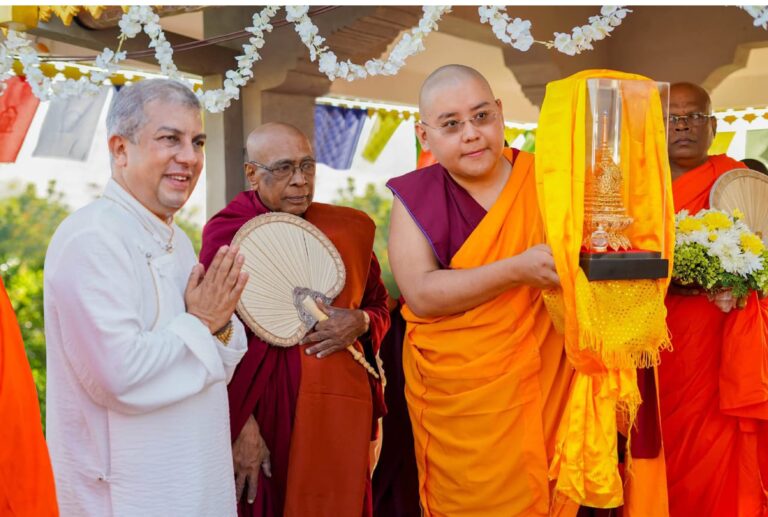His Holiness the 14th Dalai Lama stated in the Praise of Seventeen Nalanda Masters;བྱམས་པས་རྗེས་བཟུང་ཐེག་ཆེན་སྡེ་སྣོད་ཀུན། །Guided and cared for by Maitreya, you worked brilliantly to further all the Mahāyāna teachings,ལེགས་པར་སྤེལ་མཁས་རྒྱ་ཆེན་ལམ་སྟོན་ཞིང༌། །And skilfully set out the approach of vast conduct,རྒྱལ་བའི་ལུང་བཞིན་རྣམ་རིག་ཤིང་རྟའི་སྲོལ། །Founder of the tradition of Mind Only, prophesied by the Buddha—འབྱེད་མཛད་ཐོགས་མེད་ཞབས་ལ་གསོལ་བ་འདེབས། །Noble master Asaṅga, to you I pray!In Manjushir Root Tantra, it is stated:At nine hundred …
His Holiness the 14th Dalai Lama stated in the Praise of Seventeen Nalanda Masters;
བྱམས་པས་རྗེས་བཟུང་ཐེག་ཆེན་སྡེ་སྣོད་ཀུན། །
Guided and cared for by Maitreya, you worked brilliantly to further all the Mahāyāna teachings,
ལེགས་པར་སྤེལ་མཁས་རྒྱ་ཆེན་ལམ་སྟོན་ཞིང༌། །
And skilfully set out the approach of vast conduct,
རྒྱལ་བའི་ལུང་བཞིན་རྣམ་རིག་ཤིང་རྟའི་སྲོལ། །
Founder of the tradition of Mind Only, prophesied by the Buddha—
འབྱེད་མཛད་ཐོགས་མེད་ཞབས་ལ་གསོལ་བ་འདེབས། །
Noble master Asaṅga, to you I pray!
In Manjushir Root Tantra, it is stated:
At nine hundred years, after I die.
There will be named Bhikshu Asanga,
Who would master the meaning of scriptures.
He will discern the many different kinds
Of sūtras of definitive and provisional meaning
He was a teacher of worldly sciences,
and his character was one of openness.
The accomplishment of her vidyā
Is called the female messenger of Śāla.
By the power of this mantra,
One will be born with a good mind.
As it is stated, Arya Asanga was born in the fourth century CE as the son of Parkasa Shila (Selwe Tsultrim in Tibetan), after nine hundred years of Buddha’s Parinirvana. His mother taught him the Vedas, astrology, and other literature, constantly feeling that her son would one day preserve Buddha’s teachings. After her son had grown up, he asked his mother about his father’s occupation. She replied, you were not born to follow your father’s work. Out of my concern for the degeneration of Buddha’s teachings, you must follow and preserve them. You should become a monk, study the Three Baskets of Training, engage in meditation, and spread the Buddha’s teachings.
He became a monk and underwent both novice and full ordination. He memorized hundreds of thousands of teachings along with their meanings, becoming a master of the Three Baskets of Training. Struggling to comprehend the hidden meanings of the stages of realization and the path outlined in the Prajnaparamita Sutra, he dedicated himself to practices of purification, accumulating merits, and adhering strictly to his monastic precepts.
He then encountered a spiritual master of the Vajrayana tradition and received initiation from him. In a ritual involving the throwing of a flower onto a mandala to determine the appropriate deity for meditation, he discovered that Maitreya Buddha was his chosen figure. Feeling compelled to meditate with Maitreya Buddha as his deity and to practice the Mahayana teachings, he embarked on a journey to engage in meditation at the Hill of Jakang (known as Jakang in Tibetan) in Bihar.
After three years of meditation without achieving a visual of Maitreya Buddha, he became disheartened and descended from the hill. There, he encountered a man fashioning a needle from a large iron rod. Curious, he inquired, “How did you accomplish this?” The man replied:
“There is nothing that cannot be achieved by a person who is diligent.
If you do not abandon your determination,
even amidst hardship,
Mountains can be turned into dust.”
Feeling determined to intensify his efforts, he returned to meditation for another three years, yet again without any visible signs of progress. Emerging from his cave, he witnessed drops of water gradually eroding a hole in the surface of a large rock. Encouraged by this display of perseverance, he resolved to continue his meditation practice for another three years.
However, even after this extended period of dedication, he found no signs of progress and became disheartened once more. As he emerged from his cave, he observed a bird using its feathers to chip away at a rock. Inspired by the bird’s relentless effort, he renewed his enthusiasm and returned to meditation for another three years.
Despite his twelve years of meditation, he still hadn’t experienced any significant signs of progress. Then, one day, he encountered a female dog suffering from wounds and being eaten by bugs. Moved by compassion, he faced a dilemma: if he removed the bugs, they would die, but if he didn’t, the dog would perish. In an act of selfless compassion, he decided to sacrifice his own flesh to save the dog.
He searched for a razor and, realizing that removing the bugs with his hands would kill them, he closed his eyes and used his tongue to remove the bugs from the dog’s body. In that moment of selflessness, the female dog disappeared, and he experienced a profound vision of Maitreya Buddha, radiating with enlightenment.
He stated;
Oh! My only father, my only refuge,
No result even after intense effort.
Why do the rain clouds form ocean?
Thirst rise from the torment burns.
I practiced extremely hard but you have a little heart. Maitreya Buddha said,
Even the god of king allows to fall the rain,
Not ripen seed doesn’t produce the plant.
Even many Buddhas come,
Unfortunate person does not obtain anything good.
He lamented, saying:
“Oh, my sole father, my sole refuge,
Despite my intense efforts, no results appear.
Why do rain clouds form oceans?
Thirst arises from the tormenting burns.
I’ve practiced with utmost diligence, Yet, it seems you have a small heart.”
To this, Maitreya Buddha responded:
“Even the king of gods permits rain to fall,
But the unripened seed fails to sprout.
Even if many Buddhas were to come,
An unfortunate person cannot attain anything good.
He responded, acknowledging: “I have been present since the very beginning, But Karma obscured your vision, preventing you from seeing me. Now, through cultivating great compassion, you have purified this obstruction.”
Maitreya Buddha continued, saying: “You carry me on your shoulder and display me to others.”
Though nobody else had seen Maitreya Buddha, the individual was convinced by his encounter and the teachings received.
Maitreya Buddha asked, “What do you want?” He replied, “I want to spread the Mahayana teaching.” Maitreya Buddha then asked him to hold the Upper Yellow robe and took him to the Tushita heaven. He stayed there for one morning, which equated to fifty human years on earth. During his time in heaven, he listened to various Mahayana teachings from Maitreya Buddha. Particularly, he deeply listened to the Parjanaparamitra Sutra, contemplated its meaning, and meditated upon it, attaining hundreds of meditations and realizations. He also acquired the Retention of Not Forgetting and wisdom that analyses phenomena, as well as the wisdom that realizes emptiness. Consequently, he attained the Arya Bhumi (Noble Ground). He then requested Maitreya Buddha to compose textbooks describing the Mahayana paths from the Parjnaparamitra Sutra, and Maitreya Buddha composed his five works based on the Parjanaparamitra Sutra.
Among the Five Works of Maitreya Buddha, the Ornament of Realization, Ornament of Mahayana Sutra, and Discernment of Middle Way are treatises that are like a body. The Highest Continuum, Discernment of Reality, and the Chapter of Buddha Nature in the Ornament of Mahayana Sutra, Chapter of Definitions from the Discernment of Middle Way are the treaties that are like parts of the body.
When Asanga descended to earth, he landed at Makadha using his own magic and power. He taught his teachings there to many students, who attained the path of preparation and achieved various kinds of clairvoyance. He established a monastic institution there and transcribed all the teachings taught by Maitreya Buddha. Additionally, he wrote his own Bodhisattva’s Ground, Five Works of the Noble Ground, and Two Types of Mahayana Vehicle.
The five Works of Maitreya Buddha were established by scripture and reasoning. They are:
- Actuality of Ground
- Compendium of the Ascertainment of the Aspects
- Compendium of Gateway
- Compendium of Methods
- Compendium of Basis
Two Collections of Mahayana Vehicle are:
- Ahidharmasamochacaya
- Compendium of Mahayana Vehicle
Actuality of Ground describes the stages of accomplishing the path for an individual person.
Compendium of the Ascertainment of the Aspects explains the meaning factor of subject matter in Actuality of Ground.
Compendium of Basis tells us the expression of the word portion of Actuality of Ground.
Compendium of Gateway regards both the expression of word and meaning of Actuality of Ground.
Compendium of Methods shows the enumeration of thorough affliction and purification.
The Compendium of Mahayana Vehicle describes the Mahayana teachings and includes 10 points.
The Compendium of Abhidharma shows all of Buddha’s teachings are categorized into three baskets of training.
In addition, he authored the Sadhana of the Perfection of Wisdom, the Sadhana of the Perfection of Wisdom in Golden Color, the Lamp of Meditation, the Sadhana of Maitreya Buddha, and the Uncommon Array of the Qualities of Dharmakaya.
Arya Asanga, Non-Buddhism was in decline when he was spreading the Buddha’s teachings. Buddhist teachings flourished widely, and people around the world served and offered to him. Thousands and thousands of people came to receive teachings from him, and many of those interested in engaging in Buddhist practices became his disciples. He was well-known as the victory banner of Buddha’s teachings. He stayed at Nalanda University for twelve years and became a master of the Buddha’s teachings.
References:
Dalai Lama. (2021, March 12). Praise to the Seventeen Nalanda Masters. The Office of His Holiness The Dalai Lama. https://www.dalailama.com/news/2021/praise-for-seventeen-nalanda-masters
For the biography of Arya Asanga:
Wikipedia contributors. (2024, February 16). Asanga. Wikipedia. https://en.wikipedia.org/wiki/Asanga
Tsongkhapa, L. (2000). The great treatise on the stages of the path to enlightenment. Snow Lion Publications.
Tārānātha, J. (1980). Tārānātha’s history of Buddhism in India (L. Chimpa & A. Chattopadhyaya, Trans.; D. Chattopadhyaya, Ed.). Bagchi & Company. (Original work published 1608)
Get in Touch with Us
We’d love to hear from you—share your thoughts or ask a question!






